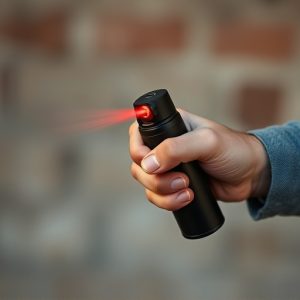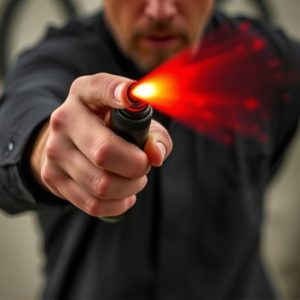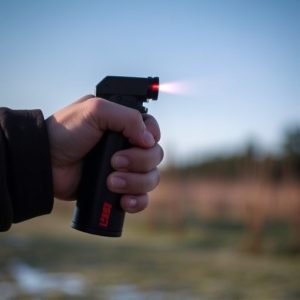Non-Lethal Pepper Spray Defense: Science, Design & Real-World Effectiveness
Non-lethal pepper spray defense, leveraging oleoresin capsicum (OC) spray, is a powerful and safe pe…….
Non-lethal pepper spray defense, leveraging oleoresin capsicum (OC) spray, is a powerful and safe personal protection tool. The active ingredient capsaicin temporarily incapacitates attackers by binding to nervous system receptors, causing burning and itching sensations that impair vision and breathing. This allows users to escape or seek help. Compactly designed aerosol canisters enable quick deployment of a mist that irritates attackers' eyes, nose, and respiratory system, providing crucial defense time without permanent harm. Legal in many regions, these devices require understanding local laws and proper training for effectiveness and safety.
“Discover the revolutionary power of non-lethal pepper spray as a personal protection device. This comprehensive guide delves into the science behind capsaicin, its effects on the human body, and the innovative design of these defensive tools. We explore how these devices operate as effective deterrents in real-world scenarios, while navigating legal considerations. Uncover the benefits of using non-lethal pepper spray for personal safety, a game-changer in self-defense strategies.”
- Understanding Non-Lethal Pepper Spray: A Comprehensive Overview
- The Science Behind Capsaicin and Its Effects on the Human Body
- Design and Functionality of a Capsaicin-Based Personal Protection Device
- Legal Considerations and Effectiveness in Real-World Scenarios
Understanding Non-Lethal Pepper Spray: A Comprehensive Overview
Non-lethal pepper spray, also known as oleoresin capsicum (OC) spray, is a powerful self-defense tool designed to incapacitate an attacker temporarily without causing serious harm. Unlike traditional pepper spray, which primarily irritates the eyes and respiratory system, non-lethal pepper spray contains capsaicin, the active ingredient found in chili peppers, that affects the body’s pain receptors. When sprayed onto the skin or eyes, capsaicin triggers a burning sensation and can disable an aggressor for several minutes, providing individuals with crucial time to escape dangerous situations.
This innovative defense mechanism is particularly popular among personal protection enthusiasts and law enforcement agencies due to its effectiveness and relatively low risk profile. Unlike firearms or other lethal weapons, non-lethal pepper spray has a wide margin of safety, making it suitable for various scenarios, from outdoor adventures to everyday self-defense. Its compact size and ease of use make it an accessible option for individuals seeking effective personal protection without the need for extensive training or physical prowess.
The Science Behind Capsaicin and Its Effects on the Human Body
Capsaicin, the active ingredient in chili peppers, is a powerful compound that has gained attention for its potential in personal protection devices. When introduced to the human body, capsaicin binds to specific receptors in the nervous system, triggering a cascade of events. This binding leads to the release of neurotransmitters and causes a sensation of burning or itching, often accompanied by pain. The effects are temporary but intense, designed to deter attackers without causing permanent harm.
In the context of non-lethal pepper spray defense, capsaicin creates a powerful disorienting effect. It can temporarily impair an assailant’s vision and breathing, providing the user with crucial time to escape or seek help. The body’s response to capsaicin is rapid, ensuring that its protective benefits are realized almost instantly. This natural compound has proven effective in various self-defense scenarios, offering individuals a safe and legal way to protect themselves from potential threats.
Design and Functionality of a Capsaicin-Based Personal Protection Device
The design of a Capsaicin-based Personal Protection Device (PPD) is centred around delivering a powerful non-lethal pepper spray defense mechanism. These devices typically incorporate a compact and easily accessible aerosol canister containing capsaicin, the active ingredient found in chili peppers. The canister is designed for quick deployment, allowing users to protect themselves from potential threats with a simple activation.
Functionality involves the release of a concentrated mist of capsaicin upon activation. This substance irritates the eyes, nose, and respiratory system of the attacker, temporarily disorienting them and providing the user with valuable time to escape or defend themselves further. The PPD’s design focuses on balance between potency—ensuring the capsaicin delivers an effective punch—and safety, guaranteeing minimal harm to bystanders and users. Regular maintenance and proper storage are crucial aspects of keeping such devices in optimal working condition.
Legal Considerations and Effectiveness in Real-World Scenarios
In many regions, non-lethal pepper spray defense devices are legal and widely accepted as personal protection tools. These products contain capsaicin, the active ingredient found in chili peppers, which can incapacitate an assailant temporarily without causing serious harm. When considering their effectiveness, it’s crucial to look beyond laboratory tests and examine real-world scenarios. Studies have shown that pepper spray can significantly deter attacks, allowing individuals to escape dangerous situations safely.
However, legal considerations are essential. While non-lethal force is generally permitted for self-defense, local laws vary widely regarding the type of devices allowed and their usage. Users must be aware of these regulations to ensure they remain within legal boundaries while benefiting from capsaicin-based personal protection. Additionally, proper training in the use of such devices is vital to guarantee effectiveness and minimize accidental harm.
In conclusion, a capsaicin-based personal protection device offers a powerful yet non-lethal pepper spray defense option. With its unique properties and effective functionality, it provides individuals with an accessible means of self-defense in various real-world scenarios. As these devices gain prominence, understanding their science, design, legal standing, and overall effectiveness is essential for those seeking alternative personal safety solutions beyond traditional lethal options.


